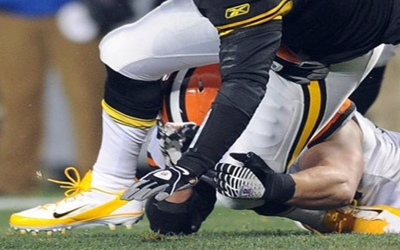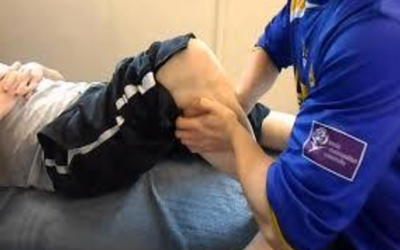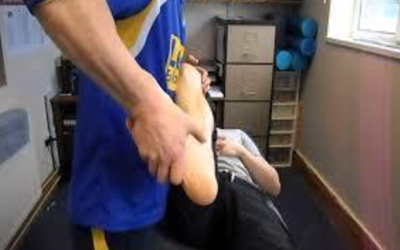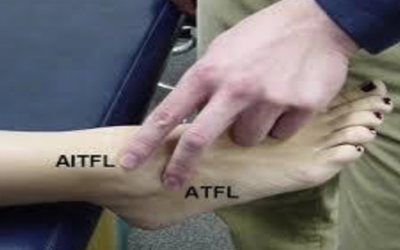The ‘Up Yours’ Test To Diagnose Ankle Injury
Posted By: Andy Barker
Over the course of a couple of seasons we had picked a few ankle syndesmosis, or high ankle injuries.
At the time the coaches generally thought I’d made up this injury!
The problem was they had not heard of this injury before.
Of course, the ankle syndesmosis injury is NOT a new injury and I certainly didn’t discover it!
I just think in recent years we have become much better at identifying these types of injuries and, differentiating ankle syndesmosis injuries from other ankle injuries.
That said, many syndesmosis ankle injuries still get missed, often misdiagnosed as a lateral ankle injury.
This present a BIG problem as these injuries are managed in the same way as a lateral ankle injury.
However, there management should be very different.
In this blog I want to cover 3 key concepts relating specifically to the ankle syndesmosis.
The Importance Of Early Diagnosis Of Ankle Syndesmosis Injuries
The Big Difference Between Ankle Syndesmosis Injuries And Other Ankle Injuries & How You Can Assess For This
Show You The ‘UP YOURS’ Syndesmosis Test To Differentiate Between An Ankle Syndesmosis & A Lateral Ankle Injury
So, you can ensure you don’t misdiagnose an ankle if you are presented with an ankle syndesmosis injury.
The Importance Of Early Diagnosis
Ankle syndesmosis injuries often present very differently to lateral ankle injuries, particularly acutely.
They often have much less of an inflammatory response; particularly swelling and associated pain.
It is not uncommon for patients and athletes to be able to continue to function quite well, even with a high-grade syndesmosis injury.
I have seen players get injured in the first few minutes of a game, sustain a high-grade injury, but be able to complete the game.
One player I remember had a Grade 3 syndesmosis injury, and managed to play the remaining 70 minutes, scoring 2 tries and getting man of the match.
They are often able to function well for short periods, largely because of a lack of inflammation and associated pain, which would be very different to a lateral ankle inversion injury, that could quickly swell and become immediately painful and stop function.
The problem we have with an ankle syndesmosis injury relates to instability.
The job of the distal syndesmosis joint is to stop excessive widening of the distal tibio-fibular joint.
Some widening is needed to accommodate the talus as the ankle moves into a dorsiflexed position, but excessive widening is a sign of injury to the distal syndesmosis.
With early detection we can manage these injuries well, very often without the need for surgery.
Unfortunately, many of these injuries are missed, often misdiagnosed as Anterior Talo-Fibular Ligament (ATFL) injuries.
As a result, they are often given ATFL management guidance, like early weight-bearing and joint mobility rehab, which can cause big problems for your patient or athlete as this may prevent adequate ligament healing and as leave your patient or athlete with an unstable ankle.
So, we need to know how to test for these injuries…
Spotting The Difference Between Ankle Syndesmosis Injuries And Other Ankle Problems
The biggest give-way of this type of injury comes even before you start your objective assessment or special testing.
The mechanism is very specific to this type of injury and very different to the more common lateral ankle injury.
An ankle syndesmosis is most commonly injured when the ankle is forced into a position of dorsiflexion and external rotation.
Being tackled from behind is a common source of injury and is why we see a high number of these injuries in sports such as rugby and the NFL.
This mechanism is very different to the more commonly injured lateral ankle ligaments like the ATFL or CFL (Calcaneo-Fibular Ligament) where the ankle will usually invert, sometimes in combination with plantar-flexion (the exact opposite to the syndesmosis).
Location of the injury and site of symptoms is also very different to lateral ankle injuries.
Commonly we see a sliding scale of injury severity as more structures become injured with a higher severity of syndesmosis injury.
Level 1 – Isolated AITFL (Anterior Inferior Tibio-Fibular Ligament) Injury
Level 2 – AITFL + PITFL (Posterior Inferior Tibio-Fibular Ligament) Injury
Level 3 – AITFL + PITFL + Interosseous Membrane Injury
Level 4 – AITFL + PITFL + Interosseous Membrane Injury + Deltoid Ligament Injury
Level 5 – All The Above Structures Plus OTHER Inc. Distal Tibia Or Fibular Fracture +/-Dislocation
The ‘UP YOURS’ Syndesmosis Test
Clearly it is important we can differentiate between ankle syndesmosis injuries and lateral ankle injuries so we can manage our patients and athletes in the best possible way.
Should you suspect an ankle syndesmosis injury the first special test to use is the squeeze test.
Squeeze Test
To complete the test, position your patient in crook lying and stabilise the foot (sitting on the foot is the easiest way).
Next, squeeze the proximal third of the tibia and fibular together (palms of hands towards each other).
What the test is doing is pushing the proximal tibia and fibular together and at the same time causing widening of the distal tibia-fibular (syndesmosis) joint.
A positive test is reproduction of distal ankle pain in the areas we highlighted above.
This is indicating that there is a compromise of the integrity of the distal syndesmosis joint.
If you get a positive squeeze test, then STOP.
Additional testing at this point is NOT needed.
Providing you have completed a thorough subjective history and the patient’s injury mechanism fits a possible syndesmosis injury, a positive squeeze test is enough to confirm your suspicion.
Completing more tests like the DF/ER test (see below) will give you the same result but at risk of causing more injury and discomfort to your patient.
DF/ER Test
Another great test to use is the ‘UP YOURS’ palpation test.
There is a clear difference in location of the AITFL and the ATFL.
This simple palpation test allows you to differentiate between different anterior ankle ligament injuries.
UP YOURS Ligament Test
You can clearly see the difference in position between the AITFL and ATFL ligaments.
Injury to the AITFL will be painful to touch on the AITFL, as will the ATFL with ATFL injury.
This test is super simple but can be really helpful in improving your diagnosis of anterior ankle injuries and in combination with both your subjective and objective testing, to ensure you don’t miss an ankle syndesmosis injury.
Key Points
It is of high importance we diagnose ankle syndesmosis injuries early and don’t mistreat them as lateral ankle injuries
Use your subjective assessment, particularly the patient’s mechanism of injury and injury location to help you differentiate between ankle syndesmosis and other ankle injuries
Use your objective testing plus palpation (the UP YOURS test) to confirm your subjective suspicion and ensure you don’t miss an ankle syndesmosis injury
PS. If you want to learn more about ankle special testing, I’ll be covering the ankle during my upcoming NGP LIVE Lower Limb course, along with how to assess, treat and rehab the knee, hip and lower back.
This course will be ONLINE and you will learn how to manage lower limb (+ lower back) injuries so you can take ANY lower limb injury, from start to finish, through a FULL rehab plan.
You will learn how to link your subjective and objective assessments together and collect ONLY the information you need so you know exactly what hands-on treatment techniques to use and what rehab exercises to prescribe.
You can find details about this course how to book your place at www.newgradphysio.com/courses
PPS. I have only just announced this course so when you visit the course page you might see my waitlist page.
This is my VIP list, put your details in the box and you will be the first to hear about exact details for this course, plus any of my future events first and have access to any discounts that I might attach to any of my events.
Image Credits:
NFL Player – orthobullets.com
Palpation Test – sciencedirect.com




